List of Sultans of Zanzibar
| Sultan of Zanzibar | |
|---|---|
|
Sultanate Flag | |
|
Majid Bin Said, first Sultan | |
| Details | |
| First monarch | Majid bin Said |
| Last monarch | Jamshid bin Abdullah |
| Formation | 1856 |
| Abolition | 1964 |
| Residence | Sultan's Palace, Stone Town |
| Appointer | Hereditary |
| Pretender(s) | Jamshid bin Abdullah |
The Sultans of Zanzibar were the rulers of the Sultanate of Zanzibar, which was created on 19 October 1856 after the death of Said bin Sultan, who had ruled Oman and Zanzibar as the Sultan of Oman since 1804. The Sultans of Zanzibar were of a cadet branch of the Al Said Dynasty of Oman.[1]
In 1698, Zanzibar became part of the overseas holdings of Oman, falling under the control of the Sultan of Oman. In 1832,[2] or 1840[3] (the date varies among sources), Said bin Sultan moved his capital from Muscat in Oman to Stone Town. He established a ruling Arab elite and encouraged the development of clove plantations, using the island's slave labour.[4] Zanzibar's commerce fell increasingly into the hands of traders from the Indian subcontinent, whom Said encouraged to settle on the island. After his death in 1856, two of his sons, Majid bin Said and Thuwaini bin Said, struggled over the succession, so Zanzibar and Oman were divided into two separate principalities; Thuwaini became the Sultan of Oman while Majid became the first Sultan of Zanzibar.[5] During his 14-year reign as Sultan, Majid consolidated his power around the East African slave trade. His successor, Barghash bin Said, helped abolish the slave trade in Zanzibar and largely developed the country's infrastructure.[6] The third Sultan, Khalifa bin Said, also furthered the country's progress toward abolishing slavery.[7]
Until 1886, the Sultan of Zanzibar controlled a substantial portion of the east African coast, known as Zanj, and trading routes extending further into the continent, as far as Kindu on the Congo River. That year, the British and Germans secretly met and re-established the area under the Sultan's rule. Over the next few years, most of the mainland possessions of the Sultanate were taken by European imperial powers. With the signing of the Heligoland-Zanzibar Treaty in 1890 during Ali bin Said's reign, Zanzibar became a British protectorate.[8] In August 1896, Britain and Zanzibar fought a 38-minute war, the shortest in recorded history, after Khalid bin Barghash had taken power after Hamid bin Thuwaini's death. The British had wanted Hamoud bin Mohammed to become Sultan, believing that he would be much easier to work with. The British gave Khalid an hour to vacate the Sultan's palace in Stone Town. Khalid failed to do so, and instead assembled an army of 2,800 men to fight the British. The British launched an attack on the palace and other locations around the city. Khalid retreated and later went into exile. Hamoud was then installed as Sultan.[9]
In December 1963, Zanzibar was granted independence by the United Kingdom and became a constitutional monarchy under the Sultan.[10] Sultan Jamshid bin Abdullah was overthrown a month later during the Zanzibar Revolution.[11] Jamshid fled into exile, and the Sultanate was replaced by the People's Republic of Zanzibar and Pemba. In April 1964, the republic was united with Tanganyika to form the United Republic of Tanganyika and Zanzibar, which became known as Tanzania six months later.[3]
Sultans of Zanzibar
| No. | Sultan | Full name | Portrait | Began rule | Ended rule | Notes |
|---|---|---|---|---|---|---|
| 1 | bin Said, MajidMajid bin Said[A] | Sheikh Majid bin Said Al-Busaid |  | 19 October 1856[12] | 7 October 1870 | Bargash bin Said attempted to usurp the throne from his brother in 1859, but failed. He was exiled to Bombay for two years.[13] |
| 2 | bin Said, BarghashBarghash bin Said | Sheikh Sir Barghash bin Said Al-Busaid | 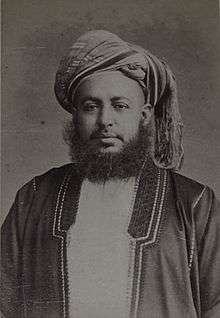 | 7 October 1870 | 26 March 1888 | Responsible for developing much of the infrastructure in Zanzibar (especially Stone Town), like piped water, telegraph cables, buildings, roads, etc. Helped abolish the slave trade in Zanzibar by signing an agreement with Britain in 1870, prohibiting slave trade in the sultanate, and closing the slave market in Mkunazini.[6] |
| 3 | bin Said, KhalifaKhalifa bin Said | Sheikh Sir Khalifa I bin Said Al-Busaid | 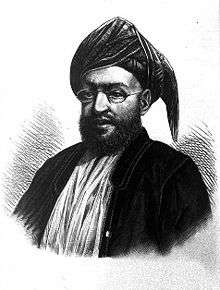 | 26 March 1888 | 13 February 1890 | Supported abolitionism, like his predecessor.[7] |
| 4 | bin Said, AliAli bin Said | Sheikh Sir Ali bin Said Al-Busaid | 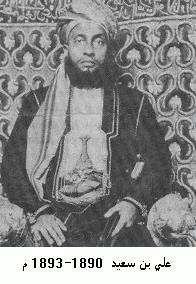 | 13 February 1890 | 5 March 1893 | The British and German Empires signed the Heligoland-Zanzibar Treaty in July 1890. This treaty turned Zanzibar into a British protectorate.[B] |
| 5 | bin Thuwayni, HamidHamid bin Thuwayni | Sheikh Sir Hamad bin Thuwaini Al-Busaid | 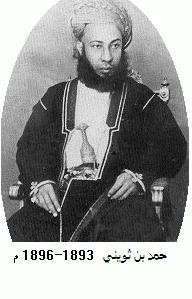 | 5 March 1893[14] | 25 August 1896 | |
| 6 | bin Barghash, KhalidKhalid bin Barghash | Sheikh Khalid bin Barghash Al-Busaid | 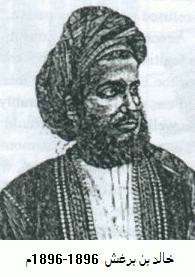 | 25 August 1896 | 27 August 1896[C] | Was a belligerent in the Anglo-Zanzibar War, the shortest war in recorded history. |
| 7 | bin Mohammed, HamoudHamoud bin Mohammed | Sheikh Sir Hamoud bin Mohammed Al-Said | 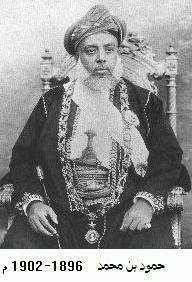 | 27 August 1896[15] | 18 July 1902 | Issued the final decree abolishing slavery from Zanzibar on 6 April 1897.[15] For this, he was knighted by Queen Victoria. |
| 8 | bin Hamud, AliAli bin Hamud | Sheikh Ali bin Hamud Al-Busaid | 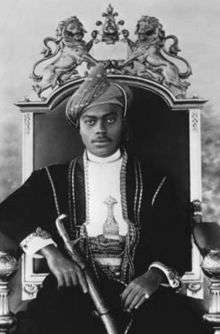 | 20 July 1902[16] | 9 December 1911[D] | The British First Minister, Mr A. Rogers, served as regent until Ali reached the age of 21 on 7 June 1905.[17] |
| 9 | bin Harub, KhalifaKhalifa bin Harub | Sheikh Sir Khalifa II bin Harub Al-Said | 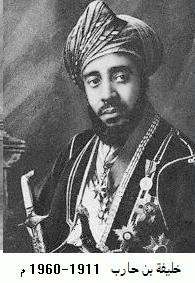 | 9 December 1911 | 9 October 1960 | Brother-in-law of Ali bin Hamud. Oversaw the construction of harbor in Stone Town and tar roads in Pemba.[6][18] |
| 10 | bin Khalifa, AbdullahAbdullah bin Khalifa | Sheikh Sir Abdullah bin Khalifa Al-Said | 9 October 1960 | 1 July 1963[E] | ||
| 11 | bin Abdullah, JamshidJamshid bin Abdullah | Sheikh Sir Jamshid bin Abdullah Al Said | 1 July 1963 | 12 January 1964[F] | On 10 December 1963, Zanzibar received its independence from the United Kingdom as a constitutional monarchy under Jamshid.[10] |
Pretenders to the Throne of Zanzibar
| No. | Sultan | Full name | Portrait | Began rule | Ended rule | Notes |
|---|---|---|---|---|---|---|
| 11 | bin Abdullah, JamshidJamshid bin Abdullah | Sayyid Sir Jamshid bin Abdullah Al Said | 12 January 1964 | Present. |
Family tree
- Sheikh Said, Sultan of Muscat, Oman and Zanzibar (1797–1856)
- Sheikh Thuwaini, Sultan of Muscat and Oman (1821–1866)
- Sheikh Harub (1849–1907)
-
 IX. Sheikh Khalifa II (26 August 1879 – 9 October 1960; r. 9 December 1911 – 9 October 1960) 9 Al-Said
IX. Sheikh Khalifa II (26 August 1879 – 9 October 1960; r. 9 December 1911 – 9 October 1960) 9 Al-Said
-
 X. Sheikh Abdullah (12 February 1910 – 1 July 1963; r. 9 October 1960 – 1 July 1963) 10 Al-Said
X. Sheikh Abdullah (12 February 1910 – 1 July 1963; r. 9 October 1960 – 1 July 1963) 10 Al-Said
-
 XI. Sheikh Jamshid (b. 16 September 1929; r. 1 July 1963 – 17 January 1964; Head of the Zanzibar house: 17 January 1964 – present) 11 Al-Said
XI. Sheikh Jamshid (b. 16 September 1929; r. 1 July 1963 – 17 January 1964; Head of the Zanzibar house: 17 January 1964 – present) 11 Al-Said
-
-
-
 V. Sheikh Hamad (1857 – 25 August 1896; r. 5 March 1893 – 25 August 1896) 5 Al-Busaid
V. Sheikh Hamad (1857 – 25 August 1896; r. 5 March 1893 – 25 August 1896) 5 Al-Busaid
- Sheikh Harub (1849–1907)
- Sheikh Muhammad (1826–1863)
 VII. Sheikh Hamud (1853 – 18 July 1902; r. 27 August 1896 – 18 July 1902) 7 Al-Said
VII. Sheikh Hamud (1853 – 18 July 1902; r. 27 August 1896 – 18 July 1902) 7 Al-Said
 VIII. Sheikh Ali II (7 June 1884 – 9 December 1911; r. 18 July 1902 – 9 December 1911) 8 Al-Busaid
VIII. Sheikh Ali II (7 June 1884 – 9 December 1911; r. 18 July 1902 – 9 December 1911) 8 Al-Busaid
 I. Sheikh Majid (1834 – 7 October 1870; r. 19 October 1856 – 7 October 1870) 1 Al-Busaid
I. Sheikh Majid (1834 – 7 October 1870; r. 19 October 1856 – 7 October 1870) 1 Al-Busaid II. Sheikh Barghash (1837 – 26 March 1888; r. 7 October 1870 – 26 March 1888) 2 Al-Busaid
II. Sheikh Barghash (1837 – 26 March 1888; r. 7 October 1870 – 26 March 1888) 2 Al-Busaid
-
 VI. Sheikh Khalid (15 December 1874 – 19 March 1927; r. 25–27 August 1896) 6 Al-Busaid
VI. Sheikh Khalid (15 December 1874 – 19 March 1927; r. 25–27 August 1896) 6 Al-Busaid
-
 III. Sheikh Khalifa I (1852 – 13 February 1890; r. 26 March 1888 – 13 February 1890) 3 Al-Busaid
III. Sheikh Khalifa I (1852 – 13 February 1890; r. 26 March 1888 – 13 February 1890) 3 Al-Busaid IV. Sheikh Ali I (September 1854 – 5 March 1893; r. 13 February 1890 – 5 March 1893) 4 Al-Busaid
IV. Sheikh Ali I (September 1854 – 5 March 1893; r. 13 February 1890 – 5 March 1893) 4 Al-Busaid
- Sheikh Thuwaini, Sultan of Muscat and Oman (1821–1866)
Footnotes
- A Majid bin Said, the youngest son of Said bin Sultan, became the Sultan of Oman after his father's death on 19 October 1856. However, Majid's elder brother, Thuwaini bin Said, contested the accession to power. Following a struggle over the position, it was decided that Zanzibar and Oman would be divided into two separate principalities. Majid would rule as the Sultan of Zanzibar while Thuwaini would rule as the Sultan of Oman.[20]
- B From 1886, the United Kingdom and Germany had plotted to obtain parts of the Zanzibar Sultanate for their own empires.[13] In October 1886, a German-British border commission established the Zanj as a 10 nautical mile (19 km) wide strip along most of the coast of East Africa, stretching from Cape Delgado (now in Mozambique) to Kipini (now in Kenya), including Mombasa and Dar es Salaam. Over the next few years, almost all of these mainland possessions were lost to European imperial powers.
- C Hamoud bin Mohammed, the son-in-law of Majid bin Said, was supposed to become the Sultan of Zanzibar after Hamid bin Thuwayni's death. However, Khalid bin Bhargash, son of Bargash bin Said, seized the Sultan's palace and declared himself the ruler of Zanzibar. The British, who had supported Hamoud, responded on 26 August by issuing an ultimatum to Khalid and his men to leave the palace within one hour. After he refused, the Royal Navy began firing at the palace and other locations in Stone Town. Khalid assembled an army of 2,800 and stationed them all around the town. Thirty-eight minutes later, Khalid retreated to the German consulate, where he was granted asylum. This conflict, known as the Anglo-Zanzibar War, was the shortest war in recorded history. Khalid later went into exile in Dar es Salaam until being captured by the British in 1916.[21][22]
- D After attending the coronation of King George V, Ali decided to abdicate from the throne to live in Europe.[6][16]
- E Abdullah bin Khalifah died from complications of diabetes.[6]
- F Jamshid bin Abdullah overthrown on 12 January 1964 during the Zanzibar Revolution.[23] Jamshid managed to flee to Great Britain with his family and ministers.[24]
See also
References
- General
- eds. Kwame Anthony Appiah ... (1999), Appiah; Gates, Henry Louis, Jr., eds., Africana: The Encyclopedia of the African and African American Experience, New York: Basic Books, ISBN 0-465-00071-1, OCLC 41649745.
- Ayany, Samuel G. (1970), A History of Zanzibar: A Study in Constitutional Development, 1934–1964, Nairobi: East African Literature Bureau, OCLC 201465.
- Ingrams, William H. (1967), Zanzibar: Its History and Its People, Abingdon: Routledge, ISBN 0-7146-1102-6, OCLC 186237036.
- Keane, Augustus H. (1907), Africa, 1 (2nd ed.), London: Edward Stanford, OCLC 6646364.
- Michler, Ian (2007), Zanzibar: The Insider's Guide (2nd ed.), Cape Town: Struik Publishers, ISBN 1-77007-014-1, OCLC 165410708.
- Owens, Geoffrey R. (2007), "Exploring the Articulation of Governmentality and Sovereignty: The Chwaka Road and the Bombardment of Zanzibar, 1895–1896", Journal of Colonialism and Colonial History, Johns Hopkins University Press, 7 (2): 1–55, OCLC 45037899, doi:10.1353/cch.2007.0036.
- Turki, Benyan Saud (1997), "The Sultan of The Arab State of Zanzibar and The Regent 1902–1905" (PDF), Journal of the Documentation and Humanities Research Center (178).
- United States Department of State (1975), Countries of the World and Their Leaders (2nd ed.), Detroit: Gale Research Company, OCLC 1492755.
- Specific
- ↑ "Zanzibar (Sultinate)". Henry Soszynski. 5 March 2012. Retrieved 30 September 2012.
- ↑ Ingrams 1967, p. 162
- 1 2 Appiah & Gates 1999, p. 2045
- ↑ Ingrams 1967, p. 163
- ↑ Ingrams 1967, pp. 163–164
- 1 2 3 4 5 Michler 2007, p. 37
- 1 2 Ingrams 1967, p. 172
- ↑ Ingrams 1967, pp. 172–173
- ↑ Michler 2007, p. 31
- 1 2 United States Department of State 1975, p. 986
- ↑ Ayany 1970, p. 122
- ↑ Ingrams 1967, pp. 162–163
- 1 2 Appiah & Gates 1999, p. 188
- ↑ Ingrams 1967, p. 173
- 1 2 Ingrams 1967, p. 175
- 1 2 Ingrams 1967, p. 176
- ↑ Turki 1997, p. 20.
- ↑ Ingrams 1967, p. 178
- ↑ Zanzibar - Royal Ark
- ↑ Keane 1907, p. 483
- ↑ Ingrams 1967, pp. 174–175
- ↑ Owens 2007, pp. 1–5
- ↑ Conley, Robert (13 January 1964), "African Revolt Overturns Arab Regime in Zanzibar", The New York Times, pp. 1, 8
- ↑ "London Cuts Support For Rent-Poor Sultan", The New York Times, p. 2, 26 January 1964
External links
.svg.png)